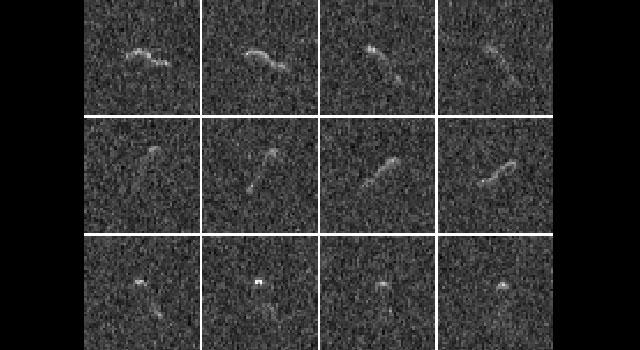EPOXI
Two intriguing investigations -- One flight-proven spacecraft
News: Space Radar Provides a Taste of Comet Hartley 2, 2010.10.28
Press Release
Space Radar Provides a Taste of Comet Hartley 22010.10.28
 Twelve radar images of the nucleus of comet Hartley 2 were obtained by the Arecibo Observatory's planetary radar from Oct 25 to 27, 2010.
Twelve radar images of the nucleus of comet Hartley 2 were obtained by the Arecibo Observatory's planetary radar from Oct 25 to 27, 2010.
Credit: NAIC-Arecibo/Harmon-Nolan
PASADENA, Calif. -- Exactly one week before the world gets a new look at comet Hartley 2 via NASA's EPOXI mission, observations of the comet by the Arecibo Planetary Radar in Puerto Rico have offered scientists a tantalizing preview.
"It kind of looks like a cross between a bowling pin and a pickle," said EPOXI project manager Tim Larson of NASA's Jet Propulsion Laboratory in Pasadena, Calif. "Only it's about 14-thousand-times larger and hurtling through space at 23 miles per second." A new image is online at www.naic.edu/~pradar/103P.
Scientists using Arecibo's massive radar dish began observations of Hartley 2 on Oct. 24, just four days after the comet made its closest approach to Earth since its discovery in 1986. (On Oct. 20, the comet came within 17.7 million kilometers, or 11 million miles, of Earth). The observations are scheduled to continue through Friday, Oct. 29.
During the Nov. 4 flyby, the cameras aboard the EPOXI mission spacecraft will get within 700 kilometers (about 435 miles) of the comet.
"Observing comet Hartley 2 from the Earth with radar was like imaging a 6-inch spinning cucumber from 836 miles away," said Jon Giorgini, a scientist at JPL and a member of the Arecibo team that imaged the comet. "Even without all the data in, we can still make some basic assertions about Hartley 2. Its nucleus is highly elongated and about 2.2 kilometers [1.4 mile] long, and it rotates around itself about once every 18 hours. In addition we now know the size, speed and direction of particles being blown off the comet, and we immediately forwarded all this information to the EPOXI team."
Just what a celestial pickle means for the EPOXI mission remains to be seen. Mission engineers and scientists are discussing the new findings and what - if anything - they signify for the upcoming comet encounter.
Along with Giorgini, observations of comet Hartley 2 were led by Arecibo Obervatory's John Harmon, with contributions by Mike Nolan and E. S. Howell.
The name EPOXI itself is a combination of the names for the two extended mission components: the extrasolar planet observations, called Extrasolar Planet Observations and Characterization (EPOCh), and the flyby of comet Hartley 2, called the Deep Impact Extended Investigation (DIXI). The spacecraft will continue to be referred to as "Deep Impact."
JPL manages the EPOXI mission for NASA's Science Mission Directorate, Washington. The University of Maryland, College Park, is home to the mission's principal investigator, Michael A'Hearn. Drake Deming of NASA's Goddard Space Flight Center, Greenbelt, Md., is the science lead for the mission's extrasolar planet observations. The spacecraft was built for NASA by Ball Aerospace & Technologies Corp., Boulder, Colo.
For more information about EPOXI visit http://www.nasa.gov/epoxi and http://epoxi.astro.umd.edu/.
DC Agle
Jet Propulsion Laboratory, Pasadena, Calif
818-393-9011
agle [at] jpl [dot] nasa [dot] gov
RELEASE: 2010-358, Source
